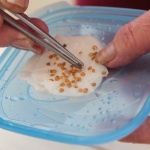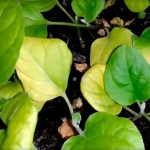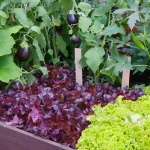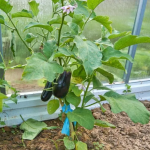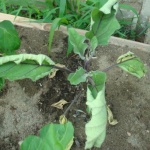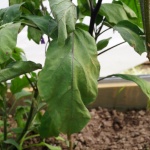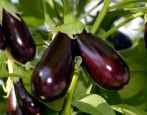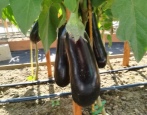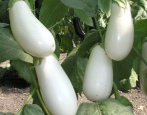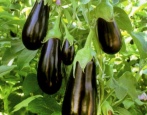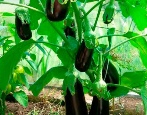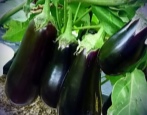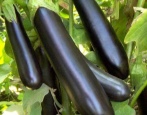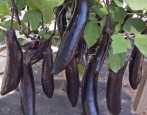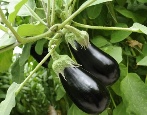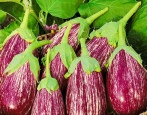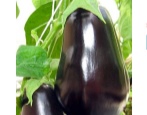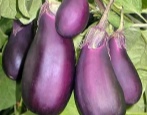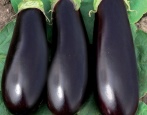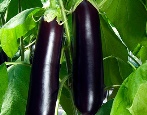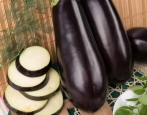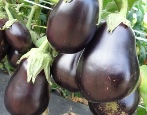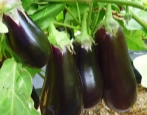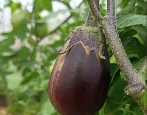
- Authors: Kashnova E.V., Rybalko A.A., Vysochin V.G., Sirota E.G., Svidovskaya N.N.
- Year of approval: 2001
- Bush height, cm: 73-105
- Fruit size: large
- Fruit shape: pear-shaped
- Fruit weight, g: 125-181 (up to 304)
- Yield: high yielding
- Marketability: 90-100%
- Ripening terms: early
- Pulp (consistency): no voids, dense
Eggplant Vera is a popular variety found in many garden plots. Gardeners appreciate the vegetable for its resistance to temperature extremes, high yields and strong immunity.
Breeding history
Domestic breeders from Barnaul were engaged in breeding Vera's eggplant. The variety entered the State Register for the first time in 2001, having successfully passed the necessary tests. Today Vera is considered one of the most popular eggplants grown in the northern regions.
Description of the variety
Vera belongs to a group of plants with an early ripening period. Main characteristics:
- bushes - compact, on average up to 105 cm;
- leaf plates are of medium size, mainly purple-green;
- flowers - small, quickly fade.
Eggplant is suitable for growing both outdoors and in a greenhouse.
Characteristics of the appearance of plants and fruits
The compact Vera eggplant bushes do not require much space on the site, which is one of the advantages of the variety. Fruit characteristics:
- calyx - with small and sparse thorns;
- eggplant shape - pear-shaped;
- length - 15-20 cm;
- weight - 125-181 (up to 304) g;
- the skin is glossy, thick, purple in color.
Eggplants are suitable for long-term transportation. Inside, the pulp is rather juicy, greenish-white in color.
Purpose and taste
Tasters appreciate the taste of Vera at its true worth. The pulp is not bitter, which allows you to use eggplant for cooking various dishes: from the first and second to a variety of blanks.
Ripening terms
The variety forms the first fruits after 118 days from the moment of planting. When grown in greenhouse conditions, the ripening time of the crop is reduced. Usually, in the second case, the crop can be harvested after 100 days.
Yield
On average, eggplant produces up to 1.2 kg per square meter. Under optimal growing conditions, the indicator can be increased to 3 kg.
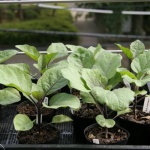
To get a tasty and bountiful eggplant crop, you must first grow strong and healthy seedlings. This culture is considered very capricious, therefore, you need to take care of seedlings when growing at home as correctly and carefully as possible.
Landing scheme
For 1 sq. m place 3 plants.
Growing and care
In the southern regions, eggplants are planted with seeds. In this case, the algorithm will look like this:
- seeds are prepared for sowing by selection, disinfection and processing;
- the soil is fertilized and loosened;
- seeds are sown in mid-April or early May.
After sowing, watered abundantly and covered with transparent material for a couple of weeks so that the eggplant takes root faster.
Growing the variety in more northern regions involves the use of seedlings.
- Preparation of planting material. This is the only way to achieve high germination capacity. During the preparation process, the seeds are soaked in a glass of water, thus sampling and removing empty samples that float to the surface. Next, the seeds are subjected to heat treatment, warming them up for several days, and then disinfected and soaked in growth stimulants.
- Disembarkation.Seeds are planted in previously prepared containers with a fertile mixture about 2 months before transplanting into open ground or greenhouse. Then each container is watered abundantly and covered with transparent material.
- Transfer. It is carried out when up to 5-6 whole leaves appear on the stems, and the height of the future bush reaches 9-10 cm.The planting is usually carried out in the warm season - May or June, when the air temperature rises above 15 degrees Celsius.
The beds for transplanting seedlings must be prepared in advance. After about a couple of weeks, fertilize the soil with compounds that reduce the pH, and also loosen the soil to saturate it with oxygen.
Faith does not require special care, which is why gardeners like it. To get a bountiful harvest, you must follow the recommendations.
- Watering. Water the plants so that the soil near the bushes is always moderately moist. At the same time, when growing eggplant in open areas, watering should be regulated depending on climatic conditions.
- Loosening. It is carried out after each watering in order to accelerate the flow of beneficial components to the roots of the plant.
- Top dressing. They are carried out no more than 3-4 times per season, fertilizing the bushes during the period of active growth, flowering and fruiting. You can determine the need for fertilization by the color of the leaves or the condition of the bush. Usually, gardeners use organic and mineral compounds, less often they resort to complex fertilizers.
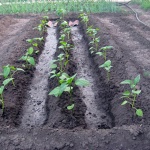
Planting eggplant is one of the most important stages in growing. When choosing a place for eggplants on your site, it is important to remember that this culture should be in warm soil, constantly illuminated by the sun. The plant is also very fond of spacious, open spaces, since its roots can grow over sufficient areas.
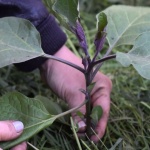
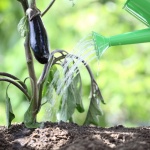
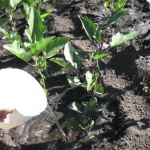
Soil requirements
Vera's eggplant prefers to grow in fertile soils with a neutral acidity index. Recommendations for choosing a site:
- preference should be given to sunny places;
- the groundwater level should be low so that the roots of the plant do not begin to rot;
- the soil should be light and fertile.
Before planting eggplants, it is recommended to thoroughly fertilize the soil with organic compounds in the form of manure or wood ash. Then the seedlings or seeds will take root faster, and the culture will give a rich harvest.
Disease and pest resistance
Eggplant Vera is considered one of the most resistant varieties to various diseases and pests. The only exception is the Colorado potato beetle, which is often found on the stems and leaves of the plant.
To prevent insect attacks and protect the crop from other negative factors, preventive treatment should be carried out.Before the procedure, it is recommended to collect the beetles by hand, as well as carefully study the instructions for using special preparations.

Eggplant is one of the most demanding crops. For its successful cultivation, it is necessary to create optimal conditions, as well as to carry out prevention and fight against diseases and pests. Eggplant often infects both fungal and viral diseases. If treatment is not started on time, you can completely lose the crop.
